How to Use Resistance Bands Correctly, According to Experts
"Hearst Magazines and Yahoo may earn commission or revenue on some items through these links."
Resistance bands are versatile tools you can use to build muscle, improve joint health, and make your workouts more fun and interesting. Best of all, anyone of any fitness level can use them! Made from thin, stretchy rubber or latex, these bands are lightweight, inexpensive, and easy to adapt to your specific needs.
The bands can generate resistance dozens of times their own weight, so you can use them instead of other forms of weights or resistance training, says Kimberly Nolan, certified personal trainer and author of Prevention’s Easy Resistance Band Slim-Down.
Meet the experts: Kimberly Nolan, C.P.T., and Chris Gagliardi, scientific education content manager, American Council on Exercise.
They’re also gentle on joints, so they’re ideal if you’re just starting to work out, returning to exercise after an injury, or if you have arthritis. Because of the bands’ stretchiness, your body works harder to stabilize and go through range of motion movements than it would if you were using rigid weights, says Nolan. These stabilization movements can increase joint strength over time.
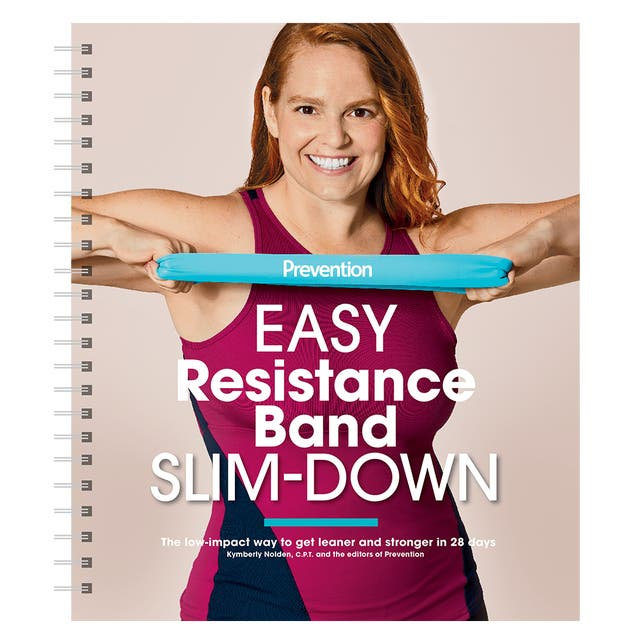
Easy Resistance Band Slim-Down
$26.95
PreventionIn addition, research shows that resistance band training provides similar muscular strength gains when compared to conventional strength training methods. “When matched for intensity, repetition and sets, you can achieve many of the same goals as you would with traditional weights or machines,” says Chris Gagliardi, scientific education content manager, American Council on Exercise. “But resistance bands are much more practical for most people.” Here’s everything you need know about how to use resistance bands:
How to choose resistance bands
A combination package that includes a variety of resistance weights (light, medium, and hard) is a good place to start because you will need varying degrees of tension to complete the desired number of sets and repetitions for each exercise, says Gagliardi. Having various weights gives you flexibility to swap what you’re using if you find the exercise is too easy (or too difficult). Some bands also have handles on them, which some people find easier to use.
In addition, some types of bands work best for specific exercises. For example, fabric mini loops may work better for exercises where the band is looped around your thighs because they don’t roll up like rubber bands may do. But rubber bands are easier to use around the arches of your feet or wrists, says Nolan.
How to warm up for resistance band training
Like any other type of exercise, you should warm up before using resistance bands to prepare your body for movement so you can avoid injury, says Nolan. The easiest way to do this is to complete several moves you plan to do, but without the bands first.
Or you can use a lighter intensity resistance band to do the same movements you plan to do later with a heavier band. The warm up should include movements in all planes of motion and should be about five to 10 minutes long. Basically, it’s a dress rehearsal of sorts. “You’re preparing the body for the demands you plan to put on it during your workout, “ says Gagliardi.
How often to do resistance band training
Like any other type of strength training, you should aim for 30 minutes of resistance band training two or more days per week. Make sure to engage all the major muscle groups including legs, back, abdomen, chest, shoulders and arms. “Resistance bands can be used as the only piece of equipment for an entire workout or can be incorporated as part of an existing workout using dumbbells or other equipment to target specific movements and muscle groups,” says Gagliardi.
One key point to remember is that how you use the bands matters. It’s not about doing reps until you can’t lift your arms! It’s about doing the exercises correctly. When you maintain the correct form as you perform an exercise, you activate the correct muscles. You’ll get more out of 12 perfectly executed reps than 25 sloppy ones, says Nolan.
How to use resistance bands
Follow these tips from Nolan for staying on track when you start a resistance band program:
Warm up for five to 10 minutes as you would for any other exercise routine.
Pay attention to your form so you get the most out of every movement.
Focus on the body part you should engage during the move.
Use short, tension-filled breaths as you hold each position.
Don’t push yourself until you feel pain; you may feel a warming sensation in your muscles, but it should not hurt.
Start by following a resistance band training plan for about a month, which will begin to build the habit of daily movement.
Stack doing the routine with something you already do daily, such as taking the dog our or scrolling the morning news, in order to make it easier to follow a plan.
Easy resistance band workout
Try this simple workout from Easy Resistance Band Slim-Down to get you started on working both your upper and lower body:
Isometric YTWS
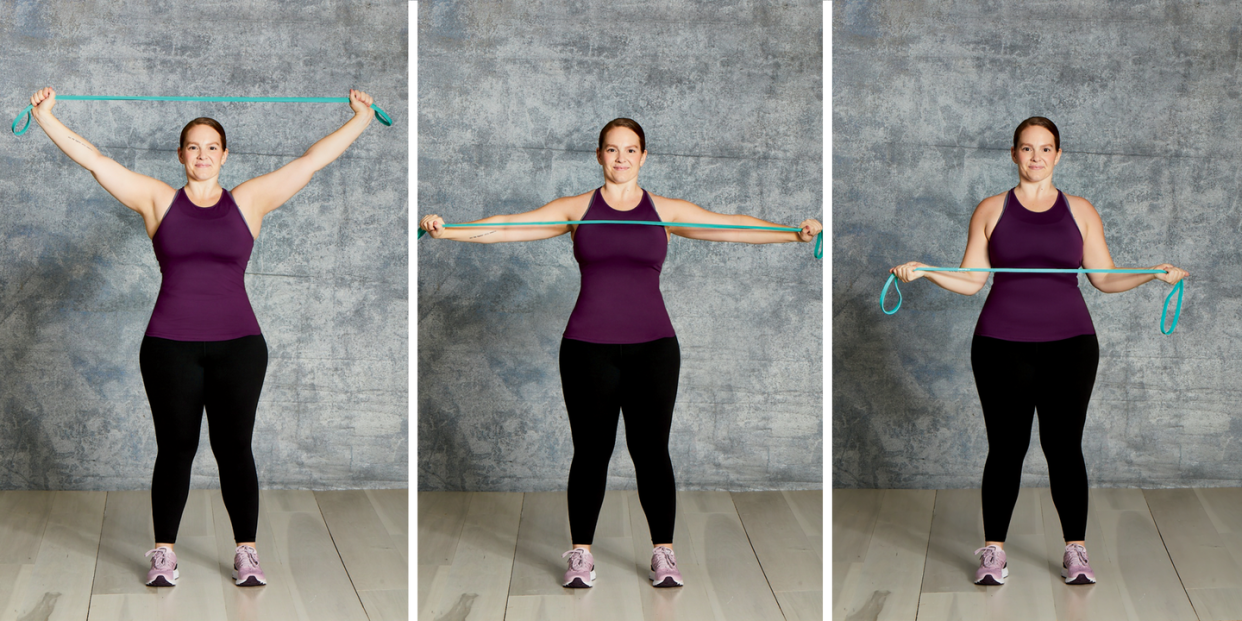
Stand with feet hip-width apart, holding one end of a long band in each hand.
Inhale to anchor your shoulder blades
Exhale to raise your arms overhead so your body forms a “Y.” Hold 40 seconds
Lower your arms to shoulder height, forming a “T.” Hold 40 seconds.
Bend your elbows and glue them to your sides to form a “W.” Hold 40 seconds.
Return to the starting position. Hold 20 seconds.
Do a total of three sets.
Single-Arm Diagonal Pushes
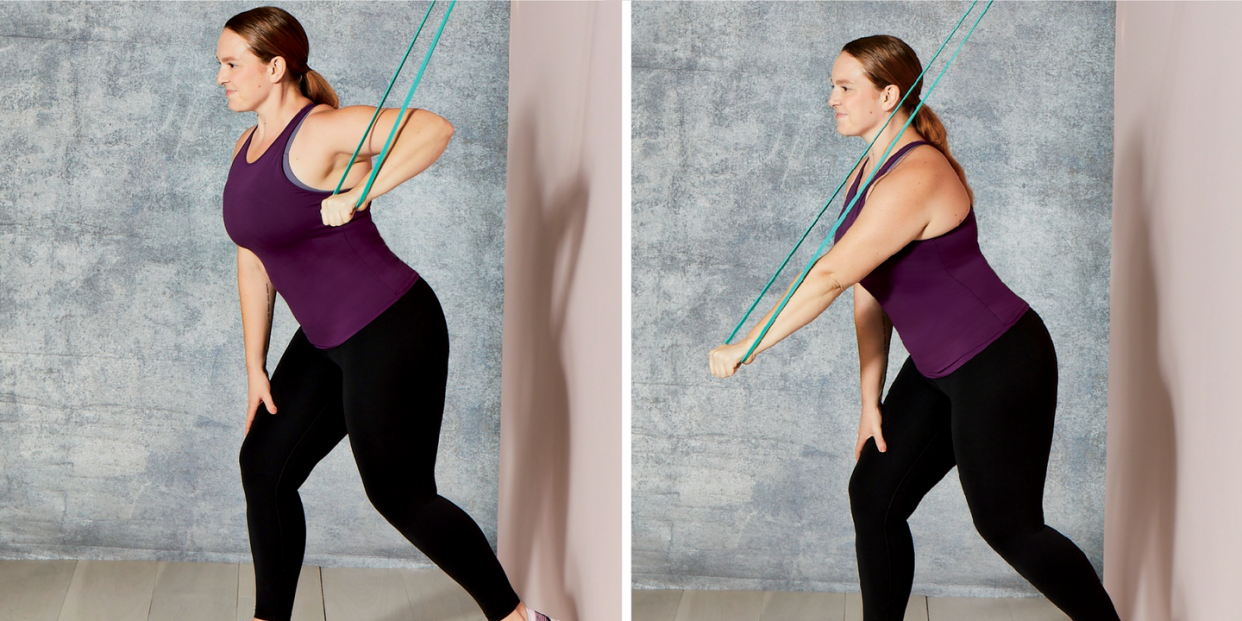
Anchor a long band high on a door. Hold the ends in your left hand and turn your body away from the door. Step your right foot in front, then bring your left hand to the front of your. Left shoulder with elbow pointing behind you.
Inhale to anchor your shoulder blades toward your hips.
Exhale to push the band at a downward angle in front of you. Hold for 40 seconds. Return to the starting position. Hold 20 seconds.
Do a total of three sets.
Pull-Aparts
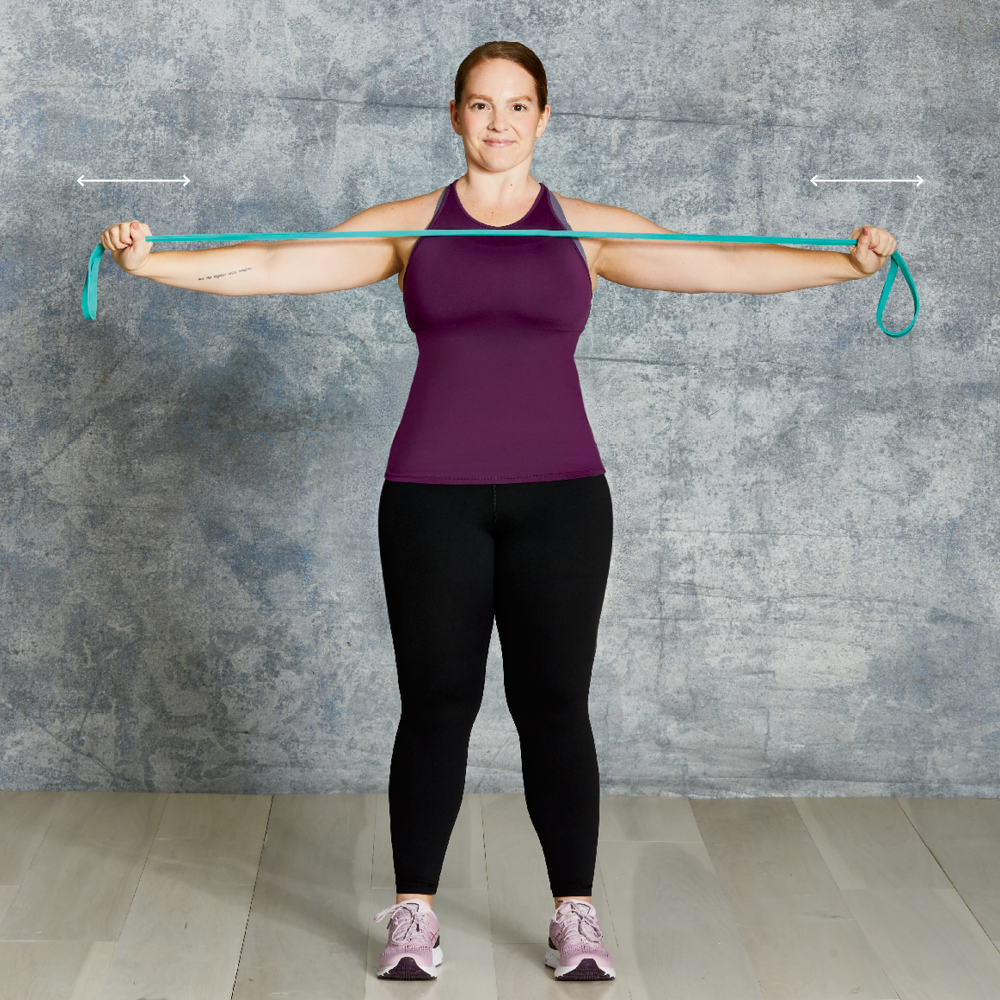
Stand with feet hip-width apart, arms extended shoulder-width in front of you holding one long band in each hand with palms facing down.
Exhale and squeeze your shoulder blades together, pulling the band apart with a slight bend in your elbows. Hold 40 seconds.
Return to the starting position. Hold 20 seconds.
Do a total of three sets.
Kickstand RDLs
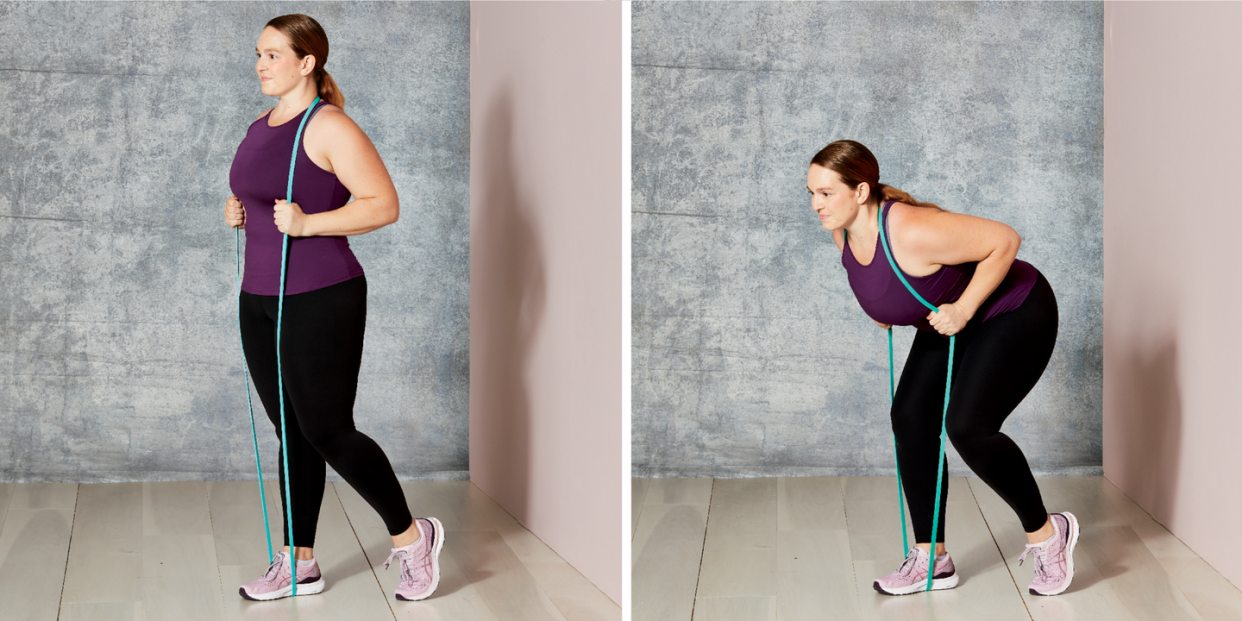
Stand with feet hip-width apart, a long loop under the arch of your right food and over your shoulders. Use your hands to hold the band and keep it across your shoulders.
Shift your head, chest and hips over your right foot, tucking your left foot back so just your toes touch the floor. Hips should be in line with each other and hips square
Inhale, and aim to sit your right hip toward your left heel while keeping your weight over your right foot. This creates a slight swivel or shift in the hips that helps you to access your right glute.
Straighten your legs and stand upright to return to the starting position.
Do a total of three sets, 40 seconds per side, resting 20 seconds between sets.
Standing Kickbacks
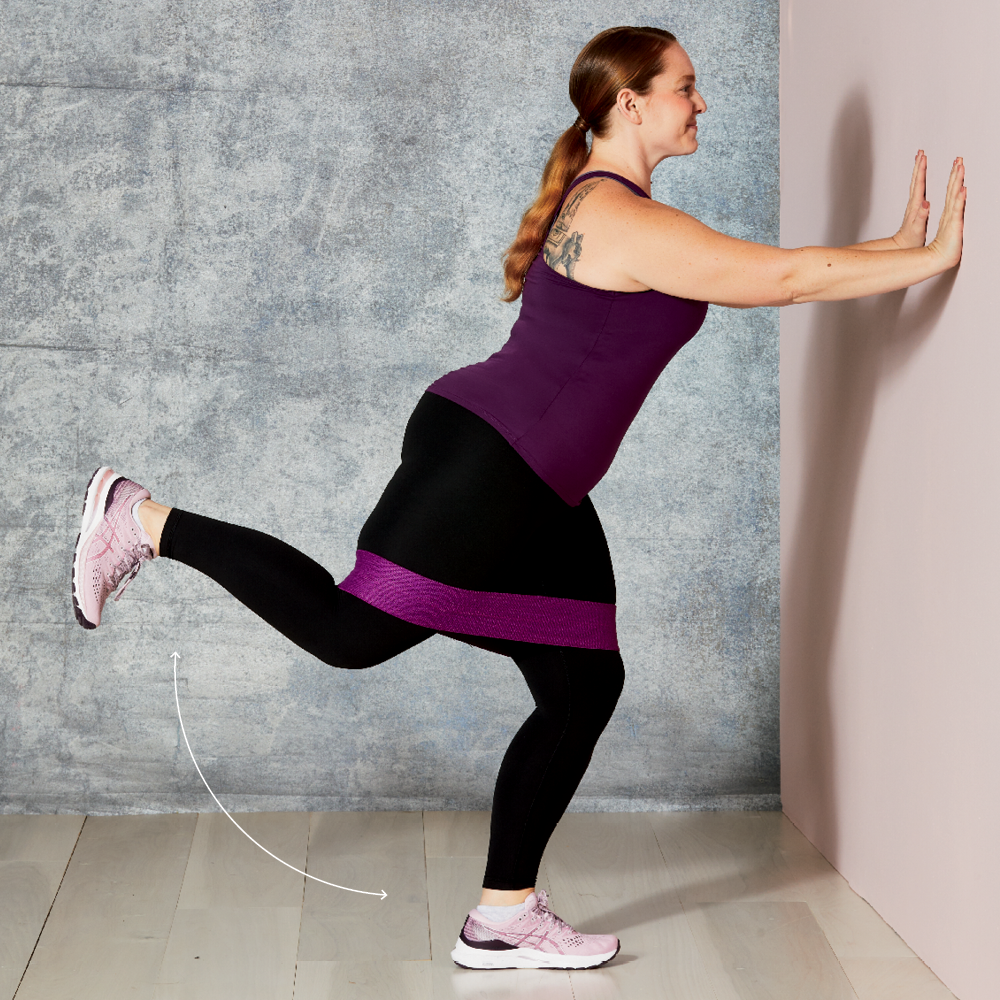
Stand facing the back of a couch or wall with feet hip-width apart, a mini loop around your legs just above or below your knees.
Shift your head, chest, and hips over to your left foot and hinge your hips back, holding onto the couch or wall.
Inhale, anchor your shoulders to your hips.
Exhale to push your left leg down into the floor as your push your right leg back, aiming to leave a footprint on the ceiling. Lower your leg back down.
Do a total of three sets, 40 seconds per side, resting 20 seconds between sets.
Pallof Presses
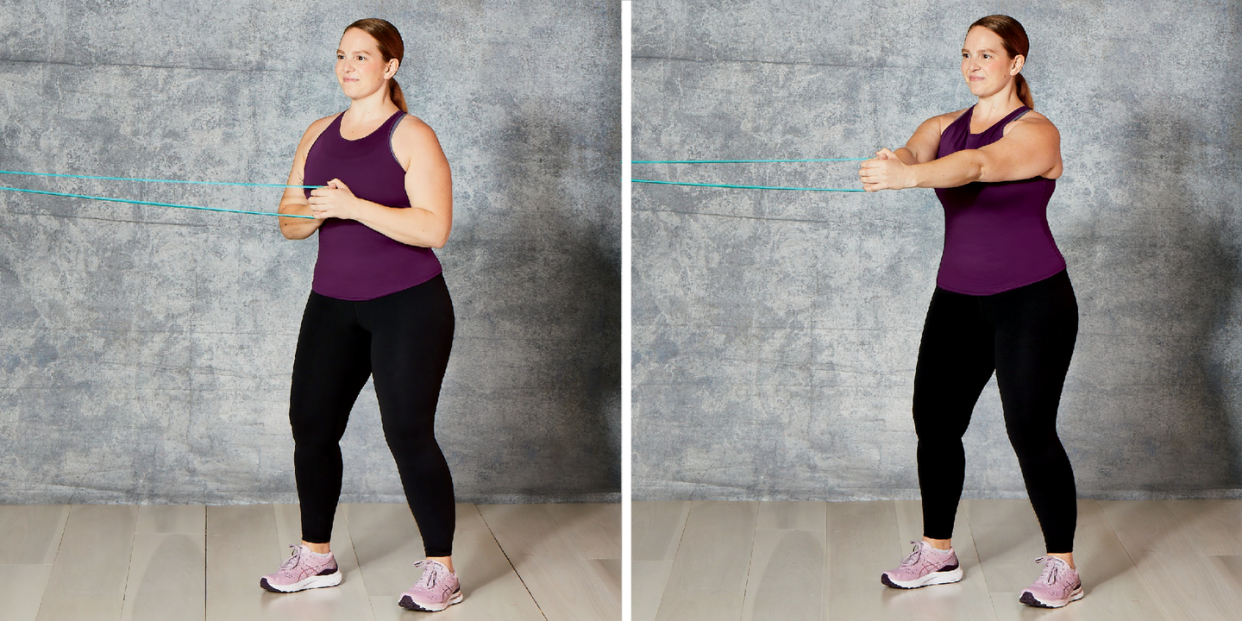
Anchor a long band around a doorknob. Stand with feet slightly wider than hip-width perpendicular to the line of your band, holding the band with both hands at sternum height in the center of your body.
Inhale, anchor your shoulder blades, exhale and push your hands straight out in front of you without letting the band pull you.
Inhale to pull your arms in, resisting the twisting pull of the band. Hold for 40 seconds.
Do a total of three sets, resting 20 seconds between sets.
Repeat this entire workout twice per week, or add some new exercises as you feel comfortable. Alternate these strength training days with cardio days to include walking, jogging, cycling, swimming or hiking.
You Might Also Like
